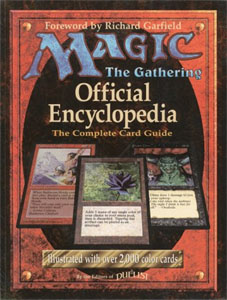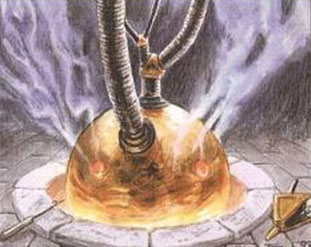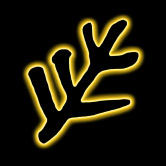 Tagline: A valuable resource for serious Magic players or those of us who just like the art.
Tagline: A valuable resource for serious Magic players or those of us who just like the art.
Let me start by explaining why I own this book.
I first encountered the phenomenon which is known as Magic the Gathering later than many of the other diehards in this industry. It was late 1993 when I first heard about the game and bought my first starter decks. I had missed the wonderful financial investment those early Alpha and Beta decks would have been (we had already entered the Unlimited Edition, which wasn’t). I had even missed the first expansion deck, Arabian Nights. Thus it was that I had my first exposure to the feeding frenzy of collectorism with the arrival of the second expansion deck, Antiquities.
It is important, I think, to remind people that this was back when the industry had lost its mind over these cards. Wizards of the Coast had proven themselves incompetent at printing to the actual demand (whether intentionally or not) and so stores were routinely ordering far more copies than they actually thought they could possibly sell (which would eventually bite everybody in the ass when Fallen Empires finally did manage to print themselves to fill all the orders from distributors). This was back when people when people were putting themselves on reserve lists for dozens of cases of cards.
Now, I liked Magic, too. Not so much for the gameplay (although it was very original and intriguing) or for the potential of deckbuilding (which didn’t appeal to me at all), but because I thought the cards were really cool. I found it interesting to look at the strange creatures and locations and spells described by these cards and have my imagination stirred by these brief glimpses and descriptions.
I did a little mathematical analysis and discovered that to get a complete set of Antiquities cards it would require the purchase of a single case. (Actually I took a random guess.) So I laid out the $70 necessary to buy the case (gah!) and, after tearing open dozens upon dozens of booster packs, finally put together my “complete set”.
And then I decided it just wasn’t worth it. I still liked the cards, I still liked the art, I still liked these little windows into the world of Dominia. I just couldn’t afford to drop $70 every couple of months (or $140+ considering that the next expansion set, IIRC, had twice as many cards). I’d rather buy, say, half a dozen roleplaying manuals with that money. Or twenty-eight paperback books.
Since that time I’ve always wished that Wizards of the Coast would publish the cards in some non-collectible, non-playable form which would let me collect the cards without going bankrupt at the same time. The Collector’s Editions they released a couple years ago were close, but ironically they were priced higher than they should have been (because they were a “special edition”), so they were still too expensive for my tastes.
Now we fast-forward five years to about six months ago when I first spotted the Official Encyclopedia on the shelf. Flipping through it I saw they had finally produced what I wanted. All of the cards produced up until 7/96 are reproduced at slightly smaller than original size, along with version notes, and some analytical text.
The book also includes a forward by Richard Garfield, an historical look at Magic, errata for the cards, misprints and oddities, promotional cards, an index for deckbuilder’s, and an index for the entire book.
So I own it because its really nice having all these cards gathered together at an affordable price. It would have been nice if the artwork had been reproduced at full size, but I won’t be too picky on that point.
It is also an interesting (if brief read) for it’s non-fiction coverage of the history of Magic.
Finally, it has a set of useful tools for deckbuilders (“professional” or otherwise).
All around this is a very nice book which fulfills a number of different roles for a number of different people. I hope it gets an update in a few years to make it more current.
Style: 4
Substance: 4
Author: Editors of Duelist
Company/Publisher: Carlton Books
Cost: n/a
Page count: 225
ISBN: 1-85868-240-1
Originally Posted: 1999/05/28
In the years since I reviewed it, this encyclopedia has, in fact, been expanded with a half dozen additional volumes and at least one new edition listing more than 7,200 cards. In recent years, of course, the internet has rendered efforts like this utterly obsolete: A quick Google search will turn up multiple sites indexing every MtG card in existence. Back in 1999, I would have salivated at the thought of it. (And, in fact, I probably did.)
I think this review also provides an excellent example of how a reviewer can bring a peculiarly idiosyncratic point of view to their treatment of a product: Most people picking up this encyclopedia would have probably been using it for deckbuilding, not lore-delving. But this is why the reviewer’s first duty to their audience is to clearly communicate their point of view while also supplying enough information about the product that those with different view points can (hopefully) intuit what their own opinions of the product might be.
MtG cards remain a wonderful goldmine of creativity that can easily be stripmined for your next D&D adventure. I’ve done it at least a half dozen times and I’ll almost certainly do it again. (As inspiration goes, it’s hard to beat a dollop of evocative text combined with lavish illustration.)
For an explanation of where these reviews came from and why you can no longer find them at RPGNet, click here.


















